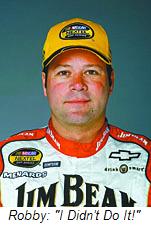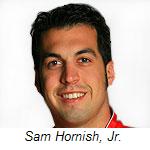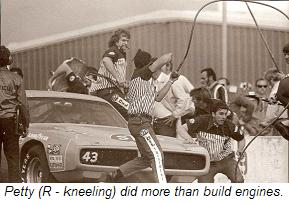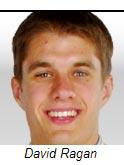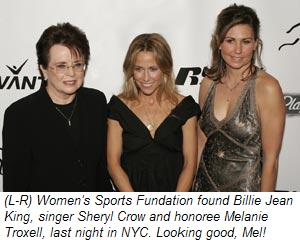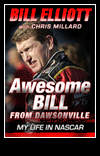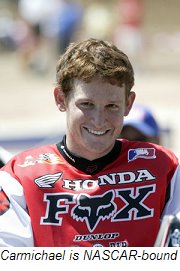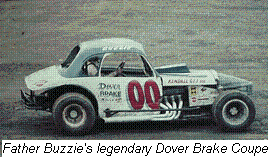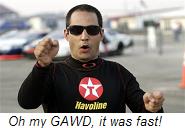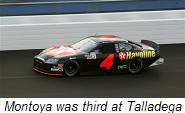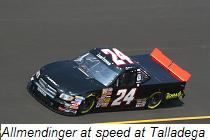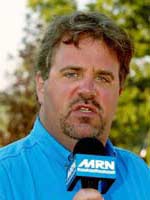
I expected the Open Wheel community to be upset over A.J. Allmendinger’s jump to the NASCAR ranks yesterday. I also figured my views on the rationale behind the move might ruffle a few feathers.
I was right on both counts.
I received a couple of angry e-mails from listeners after leaving the air last night, disagreeing with my contention that IRL and Champ Car are in danger of becoming Nextel Cup feeder series’, just like NASCAR’s Busch and Craftsman Truck Tours. Listener Dave Fothergill left little question about where he stands on the subject, writing,
“You guys might as well make the switch to a full time NASCAR talk show and drop any discussion of the other forms of motorsports. Although some of the comments you guys made today were justified, the overall vilification of open wheel racing in North America has made it clear that Sirius Speedway really only cares about what's happening in the world of stock cars.
Hopefully, we open-wheel race fans will be given a radio voice that knows, and more importantly, cares about the state of Champ Car and the IRL, and is willing to discuss it without the requisite verbal put-downs.”Mr. Fothergill, I feel your pain. But I also think you have a short memory when it comes to this show.
For the record,
Sirius Speedway has covered Open Wheel racing – both Champ Car and the Indy Racing League – since our first day on the air. During the CART bankruptcy process, we kept listeners informed on the bidding war between Champ Car’s Kevin Kalhoven, Gerald Forsythe and Paul Gentillozzi, and IRL’s Tony George. We analyzed the means and motives of all parties, called in some of the most knowledgeable people in the business to get their take, and laid the facts out as best we could to let our listeners draw an accurate conclusion.
We have been on the front lines of the IRL/Champ Car “reunification” debate from the beginning, honestly assessing the chances for a merger, talking with Open Wheel insiders to get their informed opinions, and offering our honest assessment on what ultimately turned out to be much ado about nothing.
Over the past three years I have repeatedly stated my view that both Champ Car and IRL are slowly heading down the road to ruin, simply to satisfy the colossal egos of their respective owners. On that count, many of the sport’s most knowledgeable minds seem to agree with me. Now, with drivers like Allmendinger, Juan Pablo Montoya, Jacques Villeneuve, Paul Tracy, Max Papis, Sam Hornish, Patrick Carpentier, Adrian Fernandez and Michel Jourdain, Jr., all turning to NASCAR to one degree or another, it seems obvious that many of Open Wheel racing’s brightest stars have seen the writing on the wall, as well.
Take a good, honest look at what’s going on, and tell me if most of the meaningful traffic in Open Wheel racing these days doesn’t seem to be heading out of town.
Robin Miller, one of Open Wheel racing’s most respected writers, wrote on SPEEDTV.com this week,
“Besides being a PR disaster for Champ Car…it's an emotional blow, because a winning American is exactly what this series desperately needs to win back its fan base.”
I see it, and Robin Miller obviously sees it. Mr. Fothergill, what are you missing?
NASCAR’s television ratings regularly dwarf those of the Indy Racing League and Champ Car World Series. Most weekends, NASCAR’s Saturday afternoon Busch Series race draws more viewers than
both Open Wheel events,
combined! NASCAR recently signed a new eight-year, $4.4 billion deal with four different networks; FOX, TNT, ABC/ESPN and SPEED. Champ Car and IRL pay to get their races on TV, because nobody will air them otherwise. Roush Racing boasts more corporate sponsorship than the entire starting lineup at most Champ Car or Indy Racing League events, and more cars attempt to qualify for the average Nextel Cup race than for the IRL and Champ Car race, combined.
With all that said, I have just one question for Mr. Fothergill and his merry band of Open Wheel apologists.
Am I the one with the blind spot here, or is it you?
I do not speak critically of Open Wheel racing because I enjoy seeing it fail. On the contrary. I bemoan the current state of Open Wheel racing because I love
all motorsports, and hate to see a once-proud group struggle so pitifully. I am old enough to remember the day – not so long ago – when if you asked a child to draw a picture of a racecar, he would draw an Indy Car. Today, he would break out the Crayolas and draw a picture of Jeff Gordon and the Dupont Chevrolet.
NASCAR has spirited away most of Open Wheel’s fan base, and most of its corporate support, as well. Now, it has begun the process of skimming the best drivers from the top of the Open Wheel pot. The series that gave us Andretti, the Unsers, Mears and Foyt has fallen from its lofty perch, and impact with the ground is fast approaching. Somebody needs to pull the rip cord, but unfortunately, the men that run both the IRL and Champ Car continue to insist that they’re flying, not falling.
We will continue to chronicle that story as it unfolds, and I will continue to criticize those who are selfishly allowing it to happen.
Shoot the messenger if you like.



